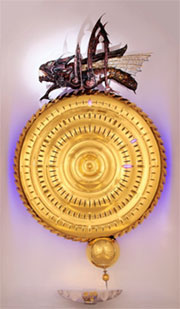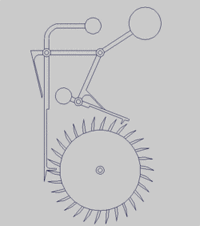CAMBRIDGE, England, Sept. 23, 2008 – When Stephen Hawking is selected for an unveiling, you know something big is happening. And indeed, on Sept. 19, the famed cosmologist was at Cambridge University to introduce a strange and provocative timepiece called the “Corpus Clock.”
Designed by John Taylor, an inventor and horologist who studied at the college in the 1950s, the clock took seven years to make and cost an impressive $1.8 million.
The Corpus Clock, though mesmerizing in its peculiarities, is a remarkable feat of engineering. This gold-plated timepiece was crafted from a single sheet of steel – the moldings were literally blasted into place by precisely-controlled explosions under the sea at a secret Dutch military research institute.
The Corpus Clock, including the Chronophage, conveys a sobering message about the ephemeral nature of time. Photo courtesy of Corpus Christi College.
Designed specifically for the exterior of Corpus Christi College’s new library, the Corpus Clock is both a radical new timepiece and a work of art. It is roughly four feet in diameter, has no hands or digital numbers, and has a time-eating beast (chronophage) perched on its uppermost vantage point. And serving as a reminder that time is fleeting, the chronophage is constantly in motion with slow-blinking eyes, a snapping jaw and a stinging tail.
The chronophage is modeled after the ‘grasshopper escapement,’ a low-friction mechanism invented by an English clockmaker, John Harrison. Typically a small internal device, the grasshopper releases a clock’s gears at a swing of its pendulum, allowing the gears to move forward by a fixed amount.

The grasshopper escapement, invented by John Harrison, shown here in motion. Photo courtesy of Wikimedia Commons.
So essentially, this team of high-precision engineers and master craftsmen created a clock that is turned inside out, giving prominence to the grasshopper and its voracious appetite for time. It is the largest grasshopper escapement of any clock in the world.
Below the creature, the time-telling part of the clock is also constantly in motion. Rather than hands or digital numerals on the face of the clock, there are a series of slits. Blue LED lights are arranged behind the slits, so that when the escape wheel moves, a series of rapidly darting lights run in concentric circles and pause at the correct hour, minute, and second.
On the hour, the clock reminds its onlookers of their mortality with the sound of a chain dropping into a wooden coffin. More playfully, the clock plays tricks on the observer, seeming occasionally to pause, run unevenly and even go backwards. All this is achieved through mechanics rather than computer programming.
The Corpus Clock runs on an electric motor, which reportedly will last for the next quarter century.
For more information, visit: www.cam.ac.uk
Watch a video of Taylor and his creation here.